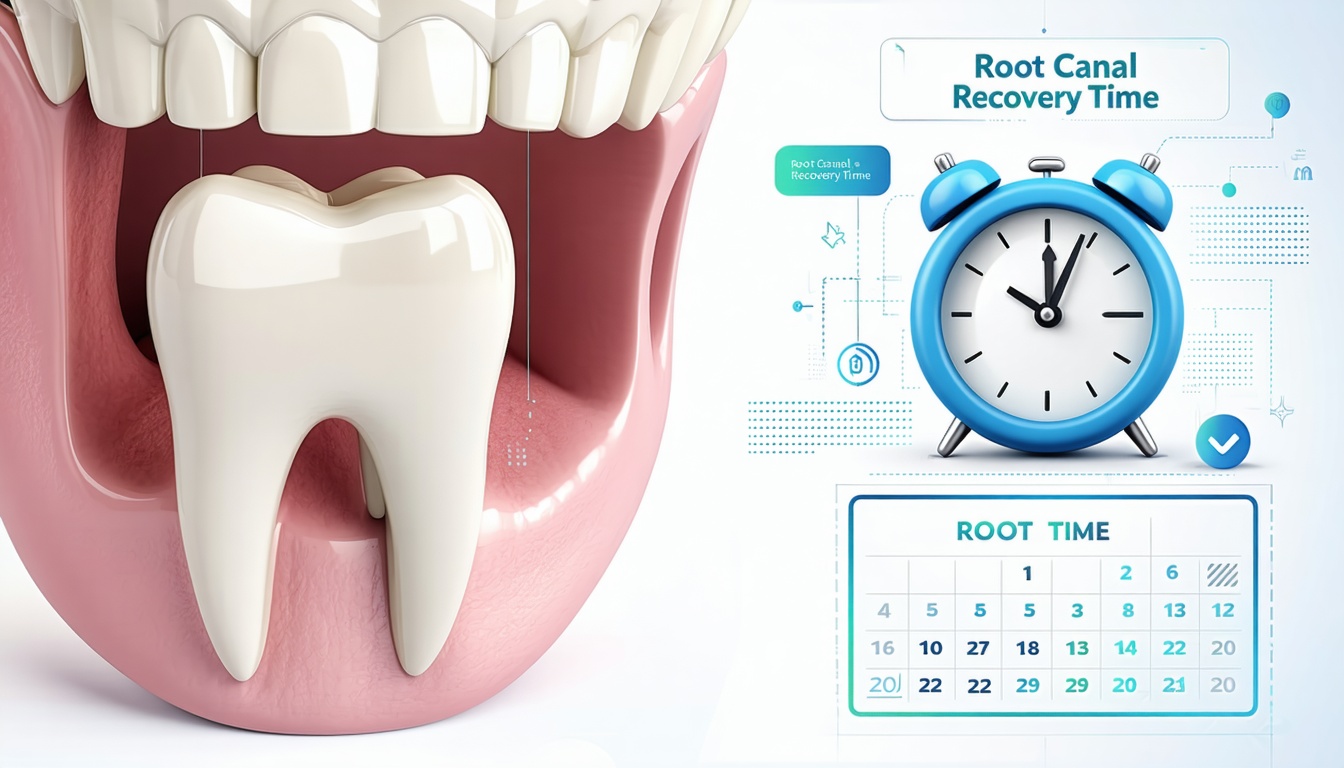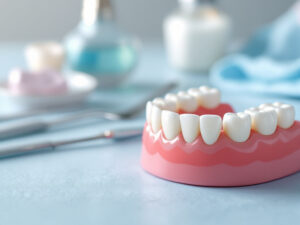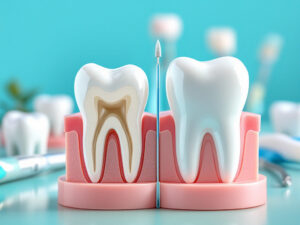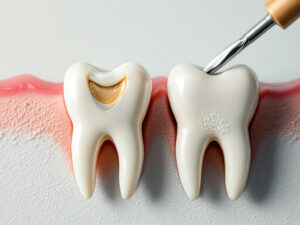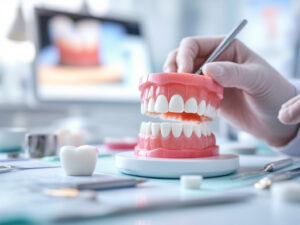Understanding Root Canal Treatment
Process Overview
Root canal treatment is a dental procedure designed to save a tooth that has become infected or damaged. During this process, your dentist removes the infected pulp from inside the tooth, cleans and disinfects the empty space, and then fills it with a special material to seal it. This treatment aims to relieve pain, preserve the natural tooth, and prevent the need for extraction.
For a detailed understanding of the specific steps involved in a root canal, refer to our article on root canal procedure steps.
Duration and Sessions
The duration of a root canal procedure typically ranges from 60 to 90 minutes. However, in some cases, more than one visit may be necessary to complete the process effectively. Each session depends on various factors, including the tooth’s condition and complexity of the treatment.
| Treatment Aspect | Details |
|---|---|
| Standard Duration | 60 to 90 minutes |
| Possible Sessions | One or more, depending on complexity |
Most people recover from a root canal within a week, experiencing mild sensitivity but usually no lasting pain beyond that period (Cleveland Clinic). If pain persists longer than a week, it is important to contact your healthcare provider for further evaluation. For an in-depth exploration of the timeline, check our article on how long does a root canal take.
Good aftercare can effectively support your recovery process. Simple steps can help you heal quickly and avoid complications. To learn more about typical side effects and how to manage them, refer to the section on common post-treatment effects.
Factors Affecting Recovery Time
Understanding the various factors that can influence your recovery time after a root canal is essential. Each individual’s experience may differ, and knowing what to expect can help you prepare.
Infection Severity
The severity of the infection prior to the root canal plays a significant role in your recovery process. If the infection has progressed extensively, you may experience increased discomfort and swelling, requiring a longer recovery time. Individuals with a history of infections or compromised immune systems may also find their healing process extended. Most people recover from root canal treatment in less than a week; however, persistent pain beyond this timeframe warrants contacting a healthcare provider.
Tooth Location
The location of the treated tooth can influence your recovery as well. Molars generally require more complex treatment due to their multiple roots, potentially resulting in a more extended recovery when compared to front teeth. The intricacies involved in accessing and treating these back teeth can lead to increased discomfort and a longer healing time.
| Tooth Type | Typical Recovery Time |
|---|---|
| Front Teeth | 3-5 days |
| Molars | 5-10 days |
Patient’s Overall Health
Your overall health significantly affects how quickly you can recover from a root canal. Generally healthy individuals may expect a quicker recovery with minimal discomfort. However, pre-existing conditions, such as diabetes, can complicate the healing process and prolong recovery. Proper management of chronic conditions is essential in minimizing any potential setbacks to your recovery (Woburn Dental Associates).
Dentist’s Skill and Experience
The expertise of the dentist performing the root canal greatly impacts your recovery time. Endodontists, who specialize in root canal treatments, possess the knowledge and skills necessary to expedite the procedure with minimal patient discomfort. Conversely, a less experienced dentist may take longer, resulting in a longer overall recovery time. Access to modern dental equipment and techniques can also play a critical role in the efficiency of treatment and subsequent recovery.
Being aware of these factors can help you better prepare for your root canal experience and recovery process. If you have concerns or questions about your specific case, consider discussing them with your dentist. For additional information on root canal treatment, you may want to check out topics such as what is root canal treatment and root canal vs tooth extraction.
Common Post-Treatment Effects
After undergoing a root canal procedure, it is common for you to experience a few temporary side effects. Understanding these effects can help you manage them effectively during your recovery period. Most individuals recover from root canal treatment in less than a week, with some lingering sensitivity but no pain lasting longer than that (Cleveland Clinic).
Pain and Sensitivity
Moderate pain or sensitivity around the treated area is typical after a root canal. This discomfort usually decreases over several days. Over-the-counter pain relievers can assist in alleviating any discomfort you may encounter. For personalized pain relief strategies, consider reviewing our article on root canal pain relief tips.
| Duration of Pain | Description |
|---|---|
| First 1-3 days | Moderate pain or discomfort is most common. |
| After 3 days | Pain generally subsides significantly. |
Swelling and Tenderness
Swelling and tenderness in the gums surrounding the treated tooth may occur. This is typically a result of the procedure and is generally short-lived. Applying cold compresses to the cheek near the treated area for 15 to 20 minutes at a time can help reduce swelling and manage pain.
| Duration of Swelling | Description |
|---|---|
| First 2 days | Peak swelling usually occurs within this timeframe. |
| After 2 days | Reduced swelling and tenderness should follow. |
Jaw Soreness
You may also experience soreness in your jaw as a result of keeping it open during the procedure. This soreness should improve in the days following your treatment. Gentle jaw exercises can help alleviate tension; however, ensure these exercises remain comfortable.
Tooth Discoloration
Tooth discoloration may happen as a side effect after a root canal; it might not be noticeable immediately after the procedure but can develop over time. If discoloration occurs, consult your dentist for available treatment options to address aesthetic concerns.
Through understanding these common post-treatment effects, you can take appropriate steps to alleviate discomfort and enhance your recovery. Following post-operative instructions, practicing good oral hygiene, avoiding hard or crunchy foods, and attending follow-up appointments are essential steps to promote healing and minimize discomfort.
Promoting Healing After Root Canal
After undergoing a root canal procedure, it is essential to follow specific practices to promote effective healing. Here are several vital methods to aid your recovery.
Oral Hygiene Practices
Maintaining good oral hygiene is crucial for a quick recovery after a root canal treatment. Gently brushing around the treated area is essential to prevent infection. You should also rinse your mouth with warm salt water to help reduce inflammation and promote healing. Here is a simple guide to follow:
| Activity | Frequency |
|---|---|
| Gently brush your teeth | Twice daily |
| Rinse with warm salt water | 2-3 times daily |
| Avoid brushing the treated tooth directly | For the first few days |
For more information about the procedure, you can refer to our article on what is root canal treatment.
Gentle Jaw Exercises
Implementing gentle jaw exercises can alleviate soreness and stiffness after your root canal. You can open and close your mouth slowly to relieve tension. Additionally, it’s advisable to avoid hard-to-chew foods for the initial few days as this can prevent unnecessary strain on the treated area.
Soft Food Diet
Adopting a soft food diet is recommended for the first several days post-treatment to minimize discomfort. Foods like yogurt, soup, and mashed potatoes are great options that are easy to chew and swallow. It is helpful to create a list of soft foods to ensure proper nutrition while your mouth heals. Below are some examples:
| Soft Food Options |
|---|
| Yogurt |
| Mashed Potatoes |
| Applesauce |
| Smoothies |
| Soups |
Make sure to consult with your dentist if you have any questions about your diet or recovery process.
Post-Procedure Care Instructions
Following the post-procedure care instructions provided by your dentist is critical for a successful recovery. These guidelines may include specific recommendations such as avoiding certain foods, taking prescribed medications, and caring for the treated tooth properly. Adhering to these instructions can help you avoid complications and ensure your recovery proceeds smoothly.
By focusing on these practices, you can support your root canal recovery time and ensure a healthier outcome. If you’re interested in understanding more about the overall procedure, you can read about the root canal procedure steps or look into root canal complications to be fully informed.
Recovery Tips for Post-Root Canal
After your root canal treatment, following the proper recovery tips is essential to ensure a smooth healing process. Here are some recommended strategies to help you manage discomfort and promote healing.
Pain Management
Pain management is an important aspect of your root canal recovery time. Over-the-counter pain relievers, such as ibuprofen or acetaminophen, can effectively help alleviate any discomfort you may experience after the procedure. It’s best to follow the dosage instructions on the medication packaging or consult your dentist for guidance on the appropriate pain relief options.
| Pain Relieving Medication | Recommended Dosage |
|---|---|
| Ibuprofen | 200-400 mg every 4-6 hours |
| Acetaminophen | 500-1000 mg every 6-8 hours |
Cold Compress Application
Applying a cold compress to the cheek near the treated tooth can significantly alleviate swelling and pain. It is recommended to apply the cold compress for 15 to 20 minutes at a time (West Lakes Dentistry). This can also help reduce any discomfort associated with inflammation post-treatment.
| Method | Duration |
|---|---|
| Cold Compress | 15-20 minutes every hour as needed |
Rest and Avoidance of Strenuous Activities
Resting is crucial during the initial recovery phase. Avoid strenuous activities and lifting heavy objects for a few days after your root canal. This will aid in faster healing and help reduce discomfort. Listening to your body and allowing it the necessary time to heal will contribute positively to your overall recovery.
| Activity | Recommendation |
|---|---|
| Strenuous Exercise | Avoid for the first few days |
| Lifting Heavy Weights | Avoid for the first few days |
Soft Foods Consumption
To facilitate a smooth recovery, it is advisable to consume soft foods following your treatment. Foods like soup, yogurt, mashed potatoes, and smoothies should be prioritized to avoid putting excess pressure on the treated tooth (West Lakes Dentistry).
| Recommended Soft Foods | Examples |
|---|---|
| Soups | Chicken noodle, tomato |
| Dairy | Yogurt, cottage cheese |
| Mashed Foods | Mashed potatoes, avocado |
| Smoothies | Fruit smoothies, protein shakes |
Implementing these recovery strategies will help ensure that your post-root canal experience is as comfortable as possible. Additional information on proper aftercare can be found in our article on root canal home care aftercare.
Differential Recovery for Molars vs. Front Teeth
Recovery Time Comparison
The recovery time for a root canal can vary significantly depending on whether the tooth involved is a molar or a front tooth. Molars typically have more complex root structures than incisors, resulting in generally longer recovery times. Below is a comparison of estimated recovery times:
| Tooth Type | Estimated Recovery Time |
|---|---|
| Molars | 1 to 2 weeks |
| Front Teeth | 3 to 7 days |
More severe infections may extend these timeframes, impacting your overall recovery experience. Those with a history of dental infections or weakened immune systems might also find their recovery takes a longer time.
Types of Root Canal Procedures
Different types of root canal procedures can affect recovery time. Here are common variations:
| Procedure Type | Complexity | Estimated Duration | Post-Procedure Follow-Up |
|---|---|---|---|
| Single-Visit Root Canal | Typically straightforward | 1.5 to 2 hours | Minimal follow-up required |
| Multiple-Visit Root Canal | More complex | 2 to 3 hours over multiple visits | More extensive follow-up necessary |
Molar treatments are often more complex, requiring additional time for proper cleaning and treatment due to their position in the mouth and the number of canals involved. A thorough approach is necessary for successful treatment of these teeth (Woburn Dental Associates).
Cost and Complexity Factors
Cost is another important factor when considering root canal treatment for molars versus front teeth. Here’s a brief overview:
| Tooth Type | Average Cost Range | Complexity |
|---|---|---|
| Molars | $800 – $1,500 | High due to multiple roots and canals |
| Front Teeth | $300 – $1,000 | Lower complexity with fewer canals |
More durable crowns are often required for molars post-treatment to withstand the forces of chewing, while front teeth may only need a filling or a simple crown for reinforcement. Calculate these factors when discussing treatment options with your dentist to align expectations accordingly.
For further insights into the root canal procedure, including steps and potential pain relief options, explore articles on what is root canal treatment and root canal pain relief tips.
Ensuring Long-Term Success
After undergoing a root canal procedure, it’s essential to take steps that promote the long-term health of the treated tooth. Proper care, regular check-ups, and a conscientious approach to oral hygiene can significantly influence your recovery and overall oral health.
Follow-Up Visits
Follow-up visits with your dentist play a crucial role in ensuring the success of your root canal treatment. These appointments allow your dentist to monitor the treated tooth, assess healing, and identify any potential complications that might arise. Regular check-ups typically take place every six months to a year after treatment. This proactive approach helps in maintaining the health of your tooth and surrounding tissues, ensuring that the root canal remains effective over time.
Long-Term Oral Health
Maintaining long-term oral health after a root canal involves adopting healthy dental habits. This includes:
- Routine Cleaning: Ensure regular brushing and flossing, focusing on the treated area to prevent plaque buildup.
- Balanced Diet: A nutritious diet can contribute to your overall oral health, helping to strengthen teeth and gums.
- Avoid Harmful Substances: Limiting sugary snacks and drinks will reduce the risk of further decay or infection.
According to studies, a successfully treated tooth can last a lifetime with adequate care, which emphasizes the importance of these practices (Winnisquam Dental).
Post-Procedure Care Importance
Post-procedure care is vital for successful recovery after a root canal treatment. Your dentist should provide detailed aftercare instructions, which may include:
- Dietary Guidelines: Eating soft foods initially and avoiding hard or chewy items can help in the healing process.
- Pain Management Techniques: Using recommended pain relief medications can alleviate discomfort as your mouth heals.
- Activity Restrictions: It’s advisable to avoid strenuous activities for a few days post-treatment to allow your body to focus on healing.
Following these guidelines can significantly reduce the risk of complications and help you regain optimal oral health. For those interested in understanding signs you need a root canal or the success rates of root canal procedures, further resources are available to assist in making informed dental decisions.

